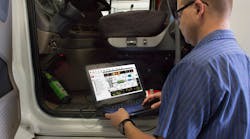All fleets share a common goal: maximize vehicle uptime. Many believe that routine maintenance alone will keep their vehicles running healthy and minimize unexpected breakdowns. However, today’s technology challenges the idea that maintenance decisions should happen solely in the shop and on a scheduled basis. Access to rich vehicle data creates opportunities to optimize maintenance plans in real-time with input throughout the organization.
As vehicle data experts, we consistently study data to improve our products, services and the industry as a whole. Examining vehicle data from a two-year period (January 2016 through January 2018), we discovered some interesting numbers.
On average...
- 95 percent of vehicles currently register some type of fault.
- 58 percent of vehicles currently register an active fault.
- 34 percent of vehicles currently register a fault that is likely to escalate.
Address potential escalation issues
Recognizing that many faults do not trigger a dash light, even a proactive driver often has no indicator that he or she needs to report an issue to the fleet’s dispatcher or maintenance team. Knowing a third of the vehicles on the road are experiencing a fault that is likely to escalate, which tools and services should fleets use to convert vehicle data into actionable information that drives uptime? Below are a few suggestions:
- Utilize an advanced in-shop diagnostic and repair solution
- Implement and utilize a remote diagnostics platform
- Utilize data analytics
According to Dave Covington, Noregon’s chief technology officer, fleets must not simply pick and choose from the above methods, but rather tie them together to structure the company’s approach to maintenance to improve overall fleet health.
“Fleet managers can’t just focus on one area of their business to optimize uptime,” Covington says. “It requires a collective effort from many areas of the organization.”
In-shop tool options
It can be extremely time-consuming to ask a technician to understand total vehicle health by diagnosing on a component-by-component basis. This not only requires learning a number of OEM applications, but also spending the time to switch between the various applications, on every vehicle, to diagnose each component. However, it is still imperative to invest in an all-makes, models and components solution that gives technicians a holistic view of the vehicle.
For example, JPRO Professional detects all faults on all electronic components, and provides information to help the technician discover the root cause. When paired with the integrated troubleshooting module, NextStep, technicians have the tools to make long-lasting repairs after the root cause is determined, regardless of the vehicle brand.
“It is vital for your tool to detect more than just active faults so technicians can discover looming issues that could sideline the vehicle,” Covington says. “Using [a diagnostic tool such as] JPRO, technicians easily discover other types of faults, such as ‘inactive’ or ‘pending,’ that may have a high count or an FMI (failure mode identifier) that indicates a preventative repair is the best option for that vehicle’s long-term health.”
Additionally, it is important that technicians use these tools regardless of the reason the vehicle is in the shop. Remember that not all faults trigger a dash light or produce symptoms noticeable by a driver, so even if the vehicle is just in the shop for new tires, always connect the vehicle to the in-shop tool and get a diagnostic overview of the entire vehicle.
Remote monitoring and diagnosis
Gone are the days of waiting for shop visits to know the health status of vehicles. With today’s technology, fleets can have their vehicle data transformed into actionable information in real-time. Utilizing a remote diagnostics platform, fleets are able to detect faults as they happen, discern the threat to their vehicle, view fault histories to see if it is a recurring issue and quickly formulate a plan that maximizes uptime.
A major benefit of monitoring vehicles in real-time is the ability to detect issues that can be fixed before escalating into problems requiring a costly repair.
“Think about how many issues can be fixed by a simple driver action,” Covington says. “For example, [Noregon’s remote diagnostics module] TripVision informs users of vehicles with low coolant levels. If the driver simply adds more coolant at the next rest stop, the fault will likely go away, as will the corresponding risk. If this issue remains undetected, it can escalate to something as serious as the engine locking up.”
Make purchase decisions with data
It is common for maintenance decisions to occur in the shop and on the road, but they also sometimes happen before a vehicle or component is purchased.
Using the information uncovered by analytics, vehicle owners can increase uptime simply by making informed purchasing decisions.
“A common question received by our analytics department revolves around determining the best vehicle configurations for a fleet,” Covington explains. “We can supplement your maintenance data with one of the largest databases in the industry to determine which vehicle, or even which individual components, work best for your needs. Our data analytics professionals uncover information like which configuration is producing the best gas mileage, or which combination of components is leading to the most faults.”
Conclusion
Maintenance is the responsibility of technicians, managers and executive decision makers. All members of the organization need to use solutions that provide consistency with their vehicle data.
This is why it is critical for in-shop solutions, such as JPRO, to work with remote diagnostics platforms, such as TripVision, to share access to vehicle data. This way, what managers and dispatchers see on the road will be the same information available to technicians in the shop.
Additionally, data analytics professionals can also utilize that same data to provide insights to make better business decisions. By bringing clarity to data inside and outside the shop, maintenance becomes an organization-wide initiative and uptime is naturally improved.
Ben Osborne is the Marketing Communications Manager for Noregon. Since joining Noregon at the beginning of 2016, Osborne has worked closely with the company’s vehicle data experts to promote initiatives that help drive forward the trucking industry.



